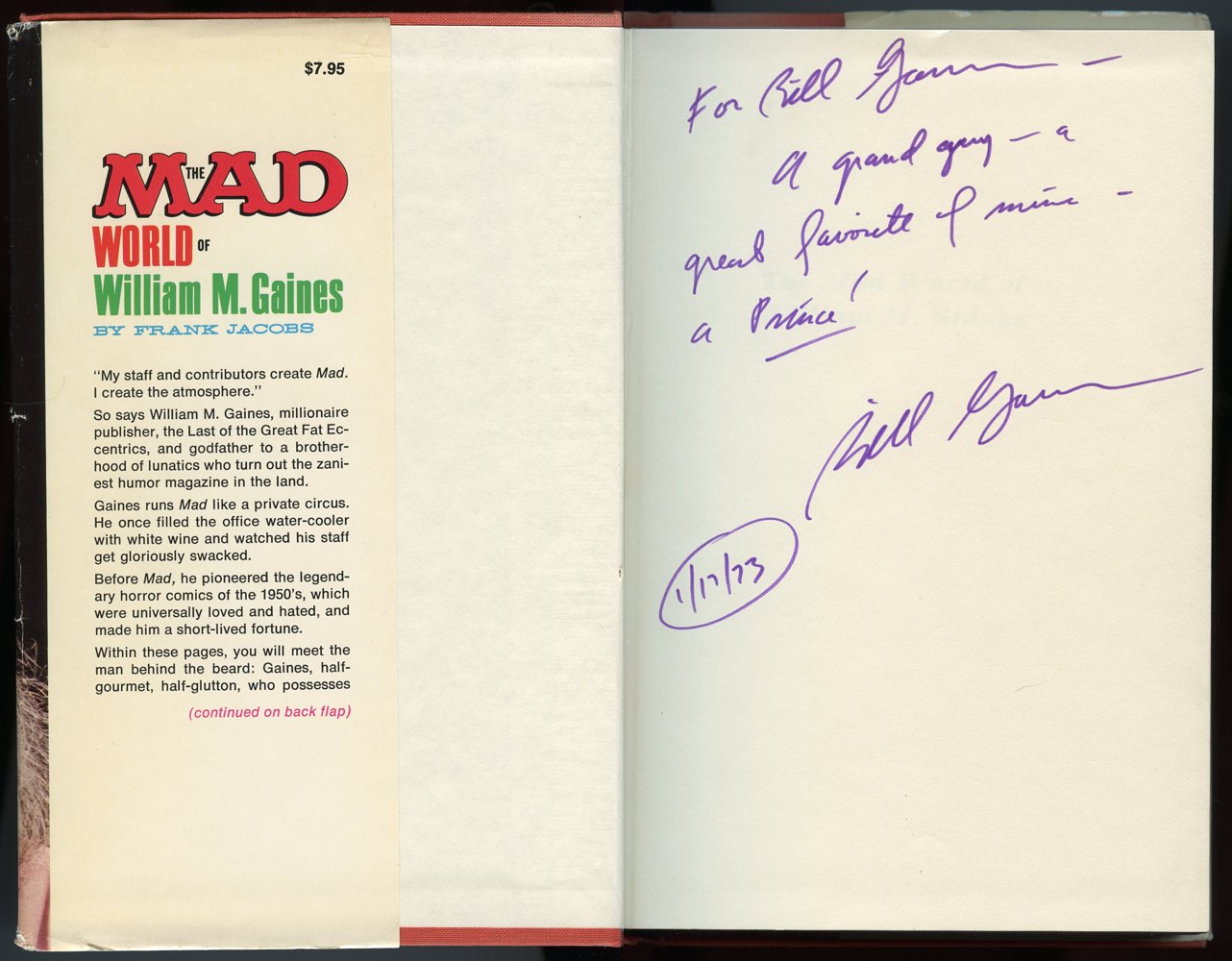|
The Mad World of William M. Gaines - by Frank Jacobs1972 Hardcover / 1973 Paperback
John Putnam cover photos and Don Martin cover art
Click hardcover for larger view
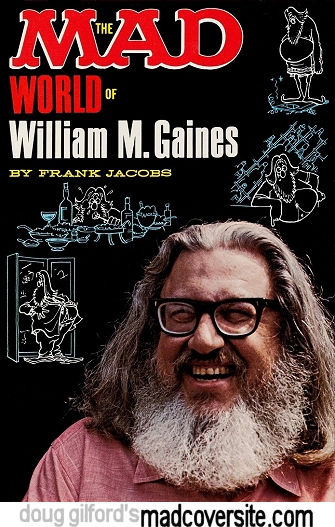
|
Click back cover for larger view
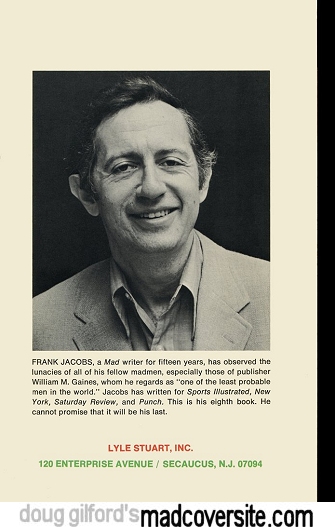
|
 |
Click paperback for larger view
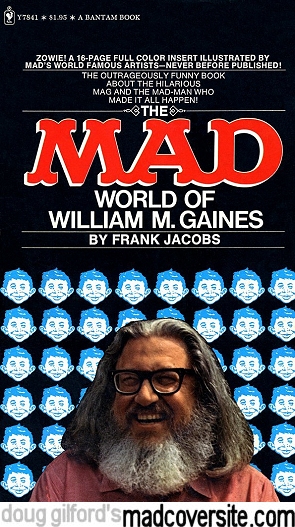
image from John H. Wilson |
Click back cover for larger view
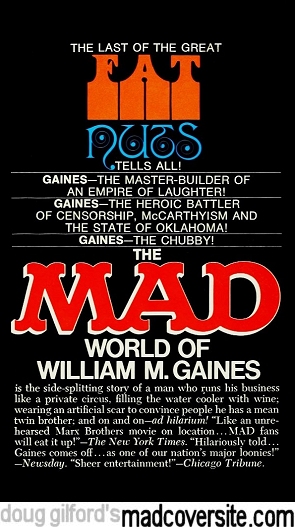
|
|
Publisher's Proem
"What we have here is a gem... Jacobs was a sucker enough to write it,
I was sucker enough to publish it and you were sucker enough to purchase it." -- Lyle Stuart
|
Introduction
- "As I got into this book, I became more and more amazed by what I didn't know about my subject." -- Frank Jacobs
- Thanks to Jerry DeFuccio, Al Feldstein, Nick Meglin, John Putnam, Fred von Bernewitz, Al Jaffee, Harvey Kurtzman,
Jack Albert, George Dougherty, Dr. Mack Lipkin, Michael Lutin, Nancy Gaines, Cathy Gaines, Wendy Gaines, Chris Gaines,
Elaine (Ginny) Gaines MacAdie, David Gaines, Edith Gaines, John Pogany-Powers, Milton Elnick, Stanley Adelman,
Annette Markell, Lyle Stuart, Sheldon Mayer, Barbara Jacobs, William M. Gaines
|
Chapter 1 - A Preface To Gaines
- "You've got to be kidding," says boy visiting office, after disheveled man claims to be the publisher of Mad.
- Restaurant in same building as Mad offices won't serve anyone without a tie. Bill won't patronize them (even after their policy changes).
- Bill avoids exertion at any cost.
- "My staff and contributors create the magazine," he has said. "What I create is the atmosphere."
- Stockroom boy Anthony is led to believe Gaines has an evil twin named Rex, with Rex's scar being the only way you can tell them apart.
- Cover of #100 mentioned. The staff works hard to sustain Mad's worthless image. Self-deprecation is the norm.
- Gaines has an infectious laugh, is not the marrying kind, and is inseparable from his magazine.
- "Join me then, as we enter the Mad World of William M. Gaines."
|
Chapter 2 - One Man's Family
- "We're going to Little Charlie's for spaghetti and clam sauce, you fat bastard," commanded Lenny (The Beard) Brenner.
- "You wind up doing most anything to hear him laugh." -- Nick Meglin, associate editor.
- Meglin came up with the idea for the #94 cover, which so impressed Bill, the huge King Kong fan.
- King Kong peers in through his office window. Zeppelins hang from the ceiling. These and other gifts take over.
- The Mad Family could not exist without Gaines. He worries about the well-being of his staff and contributors.
- Annual bonuses and qualifying for one of the Mad trips depended on your output as a contributor, how many pages you produced.
- Arnie Kogen missed the cut one year and after Gaines' mother died did not attend the funeral. "I don't have enough pages."
- Bill supplied the father image to many, including Al Feldstein.
- "Gaines is a social animal and this sometimes ruins his attempts at paternalism."
- Bill hated payola, sent back a gift of Esquire shoe polish, got after the staff for allowing engraved Zippo lighters through the door.
- He has an open-door policy to his office, which is full of "sentimental and macabre memoribilia."
- On the desk sits a "No Smoking" sign, a circular rack of rubber stamps, and a calendar with assorted "missions" to accomplish for the day.
- Editor, Al Feldstein, has a closed-door policy, isn't big on small-talk, doesn't socialize much. To Frank, a minute after a meeting, "Are you still here?"
- "Kurtzman started Mad. Feldstein made it a commercial success," says Gaines.
- Art director, John Putnam, "is a curious blend of intellectual, Francophile, hippie, collector, and dirty old man."
- Meglin "serves as a pipeline between the freelances and Feldstein..."
- "Four of Mad's veteran writers - Larry Siegel, Dick DeBartolo, Stan Hart, and Lou Silverstone - came into the fold as a result of Meglin's encouragement."
- "The magazine's contact with the outside world" is ladies' man, Jerry DeFuccio, "maintains correspondence with the magazine's readers, some of whom are celebrities."
- "...it is DeFuccio who digs up the photographs on which Mort Drucker and Angelo Torres base their caricatures."
- Assistant art director, Brenner, "is the master of the aggressive non sequitur, designed to throw the victim off-guard..."
|
Chapter 3 - You'll Never Amount To Anything
- "I was always a bumbling idiot around my father," he admits.
- Max Gaines' temper was known by all. Bill was sometimes the recipient of it physically, his mother, Jessie, verbally.
- "This hard-nosed, pain-wracked, loud, aggressive man was the father of the American comic book."
- "Why bring out comic books as premiums for other people, when they could be sold directly to kids?"
- Famous Funnies is instantly popular in 1933 and sells out.
- Young Bill makes a pest of himself in one of Max's offices, "shows flashes of brightness."
- "Max let the hottest property in comic book history (Superman) slip through his hands."
- Harry Donenfeld of Detective Comics partners with Max to from the All-American line.
- After Donenfeld gives his half of All-American to his accountant, Max sells out and retires for two weeks.
- Educational Comics is formed with very quiet titles like Picture Stories from The Bible.
- Late 1940s, the Gaines were doing OK financially, Bill survives the Army, studies to be a teacher, divorces Hazel.
- Maxwell Gaines is killed in a boating accident on Lake Placid at the family's summer home.
|
Chapter 4 - It's Your Business, Bill
- 1948 - Bill hoped his involvement with the comic business would be temporary. His mother wouldn't let it go.
- Didn't know the first thing about publishing, but hired Al Feldstein, based on his ability to draw "luscious females," to work on some western and crime stories.
- Gaines and Feldstein tried their hand at the romance game with Modern Love, A Moon, A Girl...Romance, and Saddle Romances.
- The swing to more daring content may have been brought on by Bill having "a lot of rebellion to get out of his system."
- In 1950 the old titles are replaced with The Crypt of Terror and The Vault of Horror.
- Some of Max's old staff left in protest, but there was no denying Gaines and Feldstein were onto something, with increased sales figures.
- Educational Comics became Entertaining Comics.
- The Haunt of Fear, Shock SuspenStories, Crime SuspenStories, Weird Science, and Weird Fantasy joined the others.
- Bill's ongoing doubts and nightmares about what his father would think disappeared as business boomed.
|
Chapter 5 - You Sharpen The Pencils, The Pencils Sharpen Your Head
- "Most of the stories were terror-tinged vignettes of foul play and retribution."
- Gaines and Feldstein came up with most of their own stories, but "swiped" some from Ray Bradbury and got caught. Small royalty payment to him fixed it.
- "Essential as they were, the plots and scripts played second fiddle to the artwork..." Artists became celebrities in EC's pages.
- Harvey Kurtzman is hired to produce two war comics: Two-Fisted Tales and Frontline Combat
- Slow, methodical Kurtzman is all about the smallest of details, painstaking research, documentary-like presentation. Feldstein churns out a story a day like a well-oiled machine.
- Gaines loved getting to know artists like Wally Wood, Jack Davis, John Severin, Marie Severin, Will Elder, and Johnny Craig.
- Harvey thought he should be making the kind of money Al was making, but Gaines pointed out he was only producing two books to Al's seven.
- Bill suggested he produce a humor book to increase his income. EC's Mad Mag was born, eventually shortened to Mad. It took "off like a skyrocket."
- The Korean War ended and so did Kurtzman's war titles. He'd been having trouble meeting the deadlines anyway.
- Gaines hired Mad fan Lyle Stuart to be EC's business manager.
|
Chapter 6 - Bill! Bill!
- Bill and his mother, Jessie, respected each other but did not get along well, constantly bickered.
- "It may be argued with some degree of success that Bill was not the easiest kind of son to understand."
- Flunking out of Brooklyn Poly, Bill joined the Army, became a base photographer in basic training. Asthma kept him out of WWII.
- Bill develops a compulsion for neatness soon after taking over EC.
- He marries Nancy in 1954.
|
Chapter 7 - The Ax Falls
- 1953 was "the heart of the McCarthy era, and the country was in a repressive mood."
- EC's new humor comic, Panic #1, generates intense furor over its depiction of Santa Claus. Massachusettes pulls all copies.
- After a number of articles in favor of censoring the horror comics got noticed nationally, a Senate Judiciary Committee was organized.
- Gaines and EC respond with the editorial Are You A Red Dupe? in all their books, calling the censors Communists.
- Lyle Stuart recommends Gaines testify in favor of the comics. "The committee was delighted to have him."
- Also appearing at the hearing was comic-hating psychiatrist, Frederic Wertham. His Seduction of the Innocent was making the rounds.
- Bill has a rough go of it at the hearing, loses his sharpness as it proceeds, has trouble defending the famous Johnny Craig severed head cover.
- The press piles on. Wholesalers return cases of EC comics unopened. Horror at EC is done. Publishers rally together to "atone for previous sins."
- The Comics Code Authority was the nail in the coffin for the rest of the EC books and future attempts (because Bill didn't subscribe to The Code).
- EC was blackballed. Debts piled up. Distributor Leader News owed Bill $110,000 and went bankrupt. Most everyone was let go. All that was left was Mad.
|
Chapter 8 - Hello, Harvey... Goodbye, Harvey
- Kurtzman said, "Comics were a bastard form. I wanted to get into the world of slicks. That was publishing."
- Pageant magazine offers Harvey a job. Gaines counters, "Stay, and I'll let you (turn Mad into a slick)."
- Kurtzman would stay on and Mad would avoid The Code.
- The first issue sells out and needs to be reprinted. Elder, Davis, and Wood worked with Harvey's scripts. Ernie Kovacs, Ira Wallach, and Stan Freberg articles filled things out.
- Harvey, battling with Lyle Stuart over the business end, forced Bill to let Stuart go.
- As the money dried up during the Leader News fiasco, Gaines and Kurtzman visited Gaines' mother, Jessie, and procured enough to keep afloat out of Jessie's and Bill's inheritance.
- Harvey had struck up a relationship with Hugh Hefner, sees a pathway toward more control, asks Gaines (initially through Harry Chester) for 51% of the business.
- "Throw them out the window," says Stuart. Bill parts ways with Harvey and brings Al Feldstein back on to run Mad.
- Kurtzman takes Elder, Davis, and Wood with him to the Hefner-produced Trump, but Wally returns to Mad within a month.
- "It was Harvey and his magnetism. He had a way of getting you excited about what he was doing." -- Al Jaffee
- Trump folded after two issues because of production costs.
- Gaines was not totally done with Kurtzman because Harvey sued for paperback royalties.
- Humbug and Help! followed, but met the same fate as Trump. Harvey eventually settled into Playboy's "Little Annie Fanny" with Will Elder.
|
Chapter 9 - The Making of Mad
- "I think Harvey resented it when I suggested a creative touch for an article," Putnam has said. "Not so Feldstein. The only thing he demands is clarity."
- With Elder and Davis gone, Feldstein hired Don Martin, Mort Drucker, George Woodbridge, Dave Berg,
Joe Orlando, Kelly Freas, Norman Mingo, Bob Clarke, Antonio Prohias, and Sergio Aragones.
- Will Elder did not return but Jack Davis did in 1965, contributing about an article per issue. Years earlier, right after Humbug folded, Al Jaffee returned.
- Paul Coker and Jack Rickard round out the current artists in the Usual Gang of Idiots. Dave Berg has called atheist Gaines "a highly ethical, religious man."
- Meglin, DeFuccio, and Feldstein wrote most of Mad's original stuff. Frank Jacobs was one of its earliest writers outside of the artist/writer talents.
- "Mad appeals on two levels. The first is the slapstick, sight-gag kind of humor exemplified by the lunacies of Don Martin.
The second level extends to wit, satire, and parody and requires some pre-conditioned knowledge of politics, advertising, and the entertainment media."
- Examples of Mad writers' work: Larry Siegel's Flawrence of Arabia and Put*On, Stan Hart's Passion Place,
Dick DeBartolo's Ad's We Never Got to See, Arnie Kogen's Howard Hughes' Wallet, and Tom Koch's The National Osographic Magazine.
- Larry Gore lasted a very short time as Mad's public relations man. "I couldn't communciate with Gore," Gaines has said. "He was even madder than we are."
|
Chapter 10 - Gaines The Insatiable
- "Eating is his life schtick, his grand passion, his past, present, and future thing."
- Coming in somewhere between 185 and 285 pounds, "Gaines has tried at least a dozen diets."
- "Each time I hit the Metracal trail,"he says, "it means giving up any kind of social life for months. My social life is food."
- Growing up, Bill had opportunites at every turn to eat to his heart's content.
- Nancy Gaines was a fantastic cook and would throw elaborate, 12-course dinners. "They were eating orgies," says Nick Meglin.
- Bill becomes a "wine freak" after dining with Joe Orlando in Haiti, attends exclusive wine parties, collects rare examples.
- "Gaines carries the memories of his trips in his taste buds."
|
Chapter 11 - Mind Your Own Business
- "Gaines is terrified of getting involved in an operation too big for him to handle personally."
- "...a virtual snakepit of neurotic problems..." recalls Stuart, Bill entered analysis in the early days.
- Gaines settles on Independent News as Mad's distributor after failures with others.
- Bill learns the fine art of haggling and bargaining from Jack Liebowitz, develops into an astute businessman.
- Mad takes no advertising, is still on volume one after 160 issues, comes out every 45 days,
makes no effort to push subscriptions which account for about five percent of its sales,
repackages articles in the form of Specials and paperbacks and foreign issues.
- "I do menial things no executive in his right mind would do. By making my own deposits, writing all the checks,
making all the payrolls, even serving as stockroom clerk, there's nothing that goes on that escapes me."
- He gets irritated if his suppliers haven't billed him in a timely manner.
- A few of the many lists he makes: Major Worries, Mad trips and who went, lawsuits,
Mad pin owners, clothing sizes that best fit his weight, 18 keys on his key-chain
- "In 1961, Gaines sold Mad to a conglomerate called Premier Industries," which itself became part
of a chain of acquistions for the next decade ending with Kinney Corporation which had Warner Brothers.
- Bill was always concerned his corporate handlers would force changes,
but he steered clear of it by showing Kinney his methods were best for his particular magazine.
- "Contracts are the yardsticks by which Gaines measures men, companies, deeds, even life itself."
- "Mad has forced the printing industry to pioneer." - George Dougherty
- Bill only sees the magazine right before it goes to the printer, stays out of everyone's way editorially.
|
Chapter 12 - Wives, Children, and Friends
- "The marriage of Gaines and Nancy lasted longer (than his marriage to Hazel) and proceeded uncertainly. As the years passed,
they discovered that they shared certain likes and dislikes. The likes were food and entertaining and travel. The dislikes, all too often, were each other."
- Nancy and Bill share custody of the kids (Cathy, Wendy, and Chris). Every other weekend, they "...are adept at winning him over."
- "Occasionally, the Gaines kids will invade the Mad offices, creating general havoc."
- Bill explains, "A woman to me is someone to love, to cherish, to protect, and to do what she's told."
- "Gaines seems to value three qualities in his friends - honesty, loyalty, and, probably most important, uniqueness."
- "His love of practical jokes is one of the few traits that Gaines admits he has inherited from his father."
|
Chapter 13 - 43-Man Squamish and Other Idiocies
- Frank references many Mad articles, some with excerpted text examples:
- Mad Magazine Introduces 43-Man Squamish (written by Tom Koch / George Woodbridge art)
- "Bringing Up Bonnie Prince Charlie" from Comic Strip Heroes Taken from Real Life (written by Frank Jacobs / Wally Wood art)
- "Mafia, Italy" in "Crime of the Month Club" from Future "Of-The-Month" Clubs (written by Frank Jacobs / Bob Clarke art) irked the Italian government.
- FBI trouble with "Draft Dodger" from Mad's Xmas Games (written by Albert Meglin / Bob Clarke art)
and a three-dollar bill from Mad Mintlies (written by William Garvin / Bob Clarke art)
- The Mad "Down-To-Earth" Coloring Book (written by Sy Reit / Bob Clarke art)
- "One of the most popular targets has been the syndicated comic strip." Charles Schulz wondered, "Why don't you guys take over the whole thing (Peanuts), and I'll quit?"
- Script conferences with Feldstein, Meglin, and DeFuccio generate about half of Frank's ideas.
- "The morning after Election Day, 1960, Mad became the first national magazine to bear a cover picture of President John F. Kennedy."
- The Interpreter (written by Arnie Kogen / Joe Orlando art) has James Cagney and Gary Cooper serving as Ike's interpreters with Khrushchev.
- East Side Story (written by Frank Jacobs / Mort Drucker art)
with Nick Meglin's idea of superimposing Mort Drucker's artwork over actual U.N. pictures.
- Max Brandel Protest Button has Lyndon Johnson wearing "War is Good Business - Invest your Son."
- Also Brandel did Lyndon Johnson's Vietnam scar.
- The Richard M. Nixon Presidential Primer (written by Larry Siegel) -- Feldstein thought Nixon was saturating Mad and it took a few issues to return the balance.
- The Mad Religion in America Primer (written by Larry Siegel / Paul Coker, Jr. art)
- If Other Magazines Copied Cosmopolitan's "Sex" Formula (written by Arnie Kogen / Irving Schild photos)
- After pinning their names to his Hatian voodoo doll, Gaines has watched Mad imitators come and go.
- The Mad Morality "Far be it from me to encourage the proliferation of self-confessed atheists; but as long as we have them, I hope they are of Bill Gaines's type." -- Vernard Eller
|
Chapter 14 - The Neuman Conquest
- "The idiot kid, as he is referred to by Mad staffers, owes his place in history to two men -
Mad's first editor, Harvey Kurtzman, who found the face and picked the name,
and the magazine's current editor, Al Feldstein, who put the face and name together and made the idiot kid Mad's symbol."
- Kurtzman put him on Mad's first paperback, The Mad Reader.
- Feldstein gave him his first of many Norman Mingo placements on #30's write-in candidate for president cover.
- A young Prince Charles took offense to being compared to Alfred and wrote Mad a note in protest.
- Responses from readers gave Mad many possible origins for the "What, me worry?" kid.
Some were helpful in Mad's defense when it was sued for copyright infringement by Helen Pratt Stuff.
- As an experiment, Mad put out an issue without Alfred E. Neuman on the cover. It sold quite well.
|
Chapter 15 - Sung to the Tune of "Sue Me"
- "Mad is probably the only publication that names its attorney (Jack Albert) on its masthead."
- Cynthia Piltch thought her name was too similar to "Yetta Piltch" in Protest Magazine (written by Larry Siegel / George Woodbridge art).
- The owners of the motel pictured under "Thou Shalt Not Commit Adultery" in Max Brandel's The Ten Commandments - Revisited sued for damages.
- The American Federation of Police in North Miami, Florida took issue with The Mad Flag poster.
- The Sing Along With Mad project "would evolve into a landmark case in American law."
- "We doubt," U.S. Court of Appeals, Judge Irving R. Kaufman, said, "that even so eminent a
composer as Irving Berlin should be permitted to claim a property interest in iambic pentameter."
- Gaines rarely sues anyone, but couldn't ignore the antics of Oklahoma City attorney, Clyde J. Watts, whose crusade against Mad as
"the most insidious Communist propaganda in the United States today" was having an effect on sales in Oklahoma.
Watts didn't like Paul Laikin and Mort Drucker's New and Old Versions of Lincoln's Gettysburg Address in particular.
Mad and Watts avoided a circus of a trial by getting Watts to read a statement in the courtroom that Mad wasn't Communist.
|
Chapter 16 - Gaines - After A Fashion
- "The effect of the clothes on the man is what fashion experts might regard as the Laundry Hamper Look."
- He entered his hairy period in 1968.
- Dr. Mack Lipkin said, "...I got to appreciate how sharp and shrewd he really is... When he's heavy, he's not the person anyone suspects lives in that body."
- He likes the roller derby for the violence, stopped following football and baseball, owns TVs he doesn't watch, stopped going to plays.
- "Gaines appearance is further favored by his hornrims."
- He dropped out of The American Legion and the ACLU, belongs to wine and food societies and MOMA.
- John Putnam got him interested in zeppelins, "big and unmissable" like Gaines.
- Bill owns the films King Kong, Welcome Danger, Inherit the Wind, Freaks, and The Last Angry Man.
- "I'm against seatbelts. They're un-American, police state, and make people do what they don't want to do, and I'll be Goddamned if anybody's going to wear them in my car."
- "There are four areas in which Gaines is so cheap he gets sick about it... electricity... being overweight (luggage-wise) on a plane... customs duties... telephone bills..."
- Bill is heavily insured, has obsessive-compulsive tendencies centering on neatness, placement and number of objects, "can't stand any talk about mysticism or the occult."
|
Chapter 17 - Mad About The World
- "Since 1960, Gaines has taken staff and contributors on an annual autumn outing."
"I originated the trips," he says, "with the idea that travel would be broadening and would help us put out a funnier magazine."
- Sergio Aragones joined a parade of striking workers in Florence.
- Gaines carefully ordered for 21 in San Juan, discovering near the end that the waiter was Sergio.
- The whole group in five jeeps got the sole subscriber in Port-au-Prince to renew.
- Toward the end of each junket, the Mad group resembles a traveling souvenir stand."
- Al Feldstein and Mort Drucker didn't go on trips because of the husbands-only rule. The case could be made that wives enjoyed the vacation from their husbands.
- "Most of the Mad travelers rate the Africa and Surinam trips at the top of their list... locales that most effectively took us away from the everyday."
- The group stands out in foreign lands, especially with all the facial hair. Muscovites mistaked Gaines for Karl Marx.
- After each trip, the guys get together and present Bill with a book full of "commemorative contributions," Gaines says is, "a one-of-a-kind collection of incredible talent."
|
Chapter 18 - One Last Look
- "1972 was a vintage year for Gaines."
- The film Tales from the Crypt was released to mixed reviews, but Bill thought the photography was excellent.
- The EC Fan Addict Convention drew horror buffs to mingle with their heroes and see some original art pieces.
- "...the men of Mad were guests of honor at the National Cartoonists Society."
- Gaines is now considered respectable, a far cry from his earliest days in the business.
- "Recently, 23 of his horror and suspense stories were reprinted in a gorgeous, giant-size volume by Nostalgia Press."
- Gaines serves one day a week as a business advisor for National Periodical Publications, the same "company that wanted his scalp in the fifties..."
- One thing stays the same: "Gaines and Mad, like a boy and his frog, are inseparable."
|
Index
Some Notes on Inserted Photos and Illustrations
The hardcover volume presented two black & white sections of photos and illustrations. The paperback had one color section of Mad Trip illustrations.
from the Hardcover
- Max Gaines, Harry Donenfeld, Jack Liebowitz - 1940
- Bill Gaines in the Army Air Corps - 1942
- Max and Jessie Gaines - 1946
- Bill with first wife, Hazel
- Gaines with second wife Nancy
and their children, Cathy, Wendy and Chris
- Bill with Al Feldstein
- Gaines today, minding his own business
- Bill dressed up for a wine tasting
- Nick Meglin a la Toulouse-Lautrec,
being advised by Sergio Aragones
- Al Jaffee whispering to his double
- Four Mad covers: 123, 94, 126, 86
- Gaines being welcomed in London
- Bill, Lou Silverstone, Jerry DeFuccio,
Jack Davis, and Don Martin in a Dutch castle
- The Mad crew in Africa
- Gaines as Copenhagen's Little Mermaid - Jack Davis
- Bill dozing with Lenny Brenner at Leningrad Airport
- Don Martin draws Brenner and Gaines in the Leningrad Ballet
- Bill and Lou Silverstone on a Tokyo bullet train
- John Putnam in Kyoto
- Tokyo meal featuring Al Jaffee, Gaines,
George Woodbridge, Dick DeBartolo, Don Martin
- Bill bathed in Japan - Jack Davis
|
from the Paperback
- Bill Gaines in car full of wine, bread, and cheese - Jack Davis 1969
- Gaines and The Beard as Don Quizote and Sancho Panza - Jack Davis
- The trip to Africa - Gaines as Masai warrior - Jack Davis
- Don Martin's version of Michelangelo's David
- One Sunday Afternoon in Marrakesh - Don Martin
- Bill bathed in Japan - Jack Davis
- The Madmen in Tokyo - Sergio Aragones
- Don't drink the water (in Africa)! - Lou Silverstone collage
- Don Martin draws Brenner and Gaines in the Leningrad Ballet
- A scientific explanation of the Leaning Tower - Paul Coker
- Gaines in Moscow's Red Square - Al Jaffee 1971
- Muscovite Gaines - Jack Davis
- One Fine Day in Madrid (with Bill and The Beard) - Don Martin
- Gaines in Japan - Don Martin
- Gaines as Copenhagen's Little Mermaid - Jack Davis
- Morocco again - Ali Baba Gaines - Jack Davis
|
|
